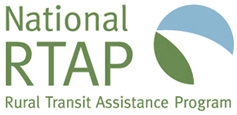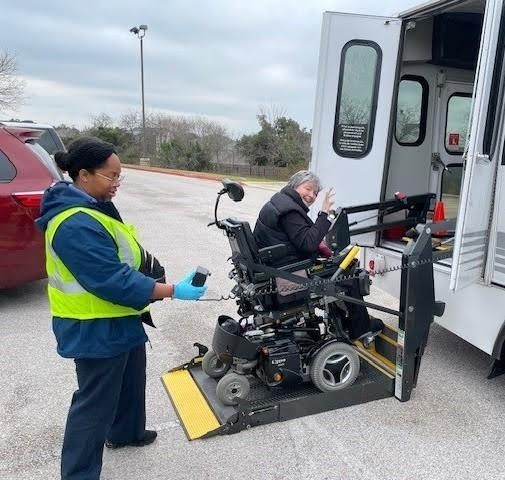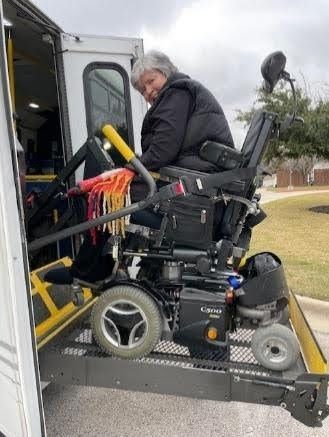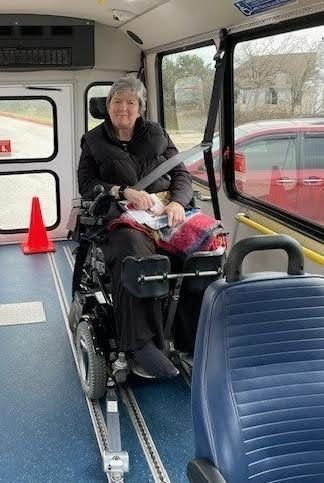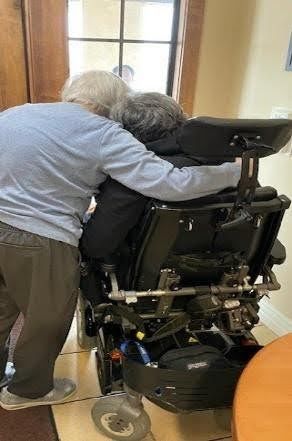Volunteer Drivers Toolkit
RESOURCES > TOOLKITS
Table of Contents
- Welcome
- RTAP Program Overview
- National RTAP
- State RTAP Programs: Status and Trends
- In-House And Outsourced Programs
- RTAP Program & Components
- Training
- Technical Assistance
- Marketing and Education
- Scholarship Programs
- Conferences and Roadeos
- Research and Data Collection
- Records Management
- Networking and Professional Development
- New RTAP Manager Succession Planning
- Sample Documents and Templates
Section 3 – Important Information About Riders
Volunteer driver programs and sponsoring organizations help to fill critical mobility gaps for people who live outside public transit service areas, need to access jobs or services outside public transit service hours, or need more personal or specialized services to travel. While some sponsoring or funding agencies require the service to be available to the general public, riders often include individuals with specialized transportation needs, such as older adults, persons with disabilities, and their personal attendants.
Riders of volunteer transportation networks typically have specialized transportation needs that cannot be met by traditional public transit providers. It may be that the rider’s needs include pick up and drop off points that are outside of the regional transit system’s service area or the rider requires more assistance with getting from their home to the curb than can be accommodated by an existing paratransit system.
Volunteer driver programs often have the flexibility to expand beyond typical trips to essential or basic (e.g., medical appointment, grocery store) services. For example, a rider might request a trip with multiple stops on the same day (e.g., 1. medical appointment --> 2. pick up medication --> 3. stop by grocery store --> 4. home).

Depending on program capabilities, volunteer driver services may also extend services to trips for other “essential services” such as financial services, legal aid, or social and religious gatherings.

This section of the Toolkit contains important information on policies and practices related specifically to riders using volunteer driver programs.
- Rider Eligibility
- Rider Registration
- Rider Information and Records
- Rider Identification
- Communication with Riders
- Information Accessibility
- Rider Expectations and Policies
- Children
- Rider Surveys
- Rider Grievances
- Section Resources
Rider Eligibility
It is important to be sure that existing and potential riders are made aware of any eligibility requirements. Rider eligibility requirements vary from program to program and are often driven by funding sources. The importance of having written policy around rider eligibility is discussed in more detail in Section 2: Volunteer Driver Programs. Eligibility requirements are highlighted in each of the case studies included in Section 7: Case Studies. The eligibility requirements for four of those programs are described below.
- SAINT serves older adults (60 years or older) and younger adults who cannot drive due to disability. The program is not able to provide rides for people who use a wheelchair. Rides are free for individuals 60 years or older.
- While almost 100 percent of Volunteers in Motion's clients are older adults, eligibility is determined based on lack of ability rather than financial status. The program collaborates with other local transportation organizations and refers individuals to appropriate services when necessary.
- WexExpress New Freedom does not impose strict eligibility restrictions; however, most passengers are older adults (60 years or older) or veterans. A smaller number of individuals with disabilities, including those receiving services through the Michigan Department of Health and Human Services (DHHS), also utilize the service.
- King County Metro Community Van is open to all members of the public for non-commute group trips ranging from two to eleven passengers. There are no age or income restrictions; however, youth under 13 must be accompanied by an adult.
Rider Registration
Volunteer driver programs should register all riders receiving service to ensure eligibility and maintain proper records. Some funding agencies require specific information regarding riders. All riders, including escorts, attendants and children, should be registered separately. The information collected in rider registration may be used to:
- Determine eligibility specific to funding sources available
- Provide emergency medical information, including, but not limited to:
- Name and phone number of emergency contact person
- Name and phone number of personal physician
- Identify the most appropriate mode of transportation
- Provide necessary data to funding agencies
See
Section 6: Program Records for more information on this topic. A Rider Registration template is included in
Section 8: Model Forms (Templates), Policies, and Procedures.
Rider Information and Records
Volunteer driver programs and sponsoring organizations must securely maintain rider records. Rider information must be collected and properly maintained using a database or an adequate system done by hand if the agency does not have access to a computer. Programs primarily use rider information for reporting purposes. Individual volunteer driver programs and sponsoring organizations may require additional information for specific program purposes. Programs must store rider files securely to maintain confidentiality. See Section 6: Program Records for a more detailed discussion on this subject and Section 7: Case Studies for examples.
A suggested list of rider information to be included in program rider records follows:
- Rider’s Name
- Address
- Phone number
- Age
- Income level
- Medicaid and/or other specific program eligibility
- Mobility information (i.e., uses a wheelchair, cane)
- Disability information (i.e., cerebral palsy, legally blind)
- Height and weight of children
- Name, address and phone number of emergency contact
In the event of an emergency, this information can also be valuable. See
Emergency Management in
Section 2: Volunteer Driver Programs for more information on this topic.
Rider Identification
Riders should be encouraged to have photo identification, either in the form of a driver's license or state identification card. The state agency responsible for issuance of state identification cards can differ from state to state. The following are examples of where to locate state identification card information:
- In Washington, the Washington Department of Licensing operates a Get an ID card website that provides a step-by-step guide on how to apply for a Washington state identification card, includes both a standard ID or enhanced ID (EID).
- In Texas, the Texas Department of Public Safety provides instructions on how to apply for an ID card on its How to Apply for a Texas Identification Card website.
Communication with Riders
Volunteer Driver Programs will want to use a wide variety of outreach methods (e.g., flyers, rack cards, service guides, social media) to ensure that their service policies and guidelines are readily available to current and prospective riders. Like other transit programs, volunteer driver programs can list the responsibilities they expect from their riders on their website and in their print materials. See more on the topic of Community Outreach in
Section 2: Volunteer Driver Programs.
Information Accessibility
Volunteer driver programs and supporting organizations are responsible for meeting federal, state, and local information accessibility requirements. To ensure compliance with applicable information accessibility requirements, a careful review of all program funding source documents is strongly recommended. Materials should be available in large font and alternative formats and use accessibility guidelines. Your website should be accessible for those who use screen readers, or navigate the webpage without a mouse. Programs will want to ensure that all materials are accessible by riders who speak languages other than English.
National RTAP’s ADA Toolkit contains valuable information, guidance, resources, and examples that will be helpful to volunteer driver programs. Resources include:
- Web Accessibility Initiative (WAI) and Web Content Accessibility Guidelines (WCAG). The WCAG 2.1 at a Glance web page is a good place to learn the basics of making web content more accessible to people with disabilities
- The Section508.gov website includes online training and guidance on how to make accessible documents and presentations.
- The basics of web accessibility can also be found on the WebAIM Introduction to Web Accessibility website.
- The Rider Assistance and Customer Service section of the ADA Toolkit provides an overview of rider assistance and sensitivity requirements under the U.S. Department of Transportation (DOT) Americans with Disabilities Act (ADA) regulations, as well as good customer service practices and tips for serving riders with various disabilities.
The
Website Accessibility page within the National RTAP Technology Tools Support Center includes additional discussion and links to additional resources on the requirements of agencies receiving federal funds (such as Section 5311) to ensure nondiscrimination in providing information to the public.
Rider Expectations and Policies
In addition to the program’s policies about requesting service, pickup times, and cancellations, King County Metro Community Van’s Rider Welcome Packet includes guidance on what types of support riders may expect from their volunteer driver (e.g. assistance with loading and transporting grocery bags or other purchases, door through door service). These materials are available in full in the Appendix to Section 7: Case Studies.
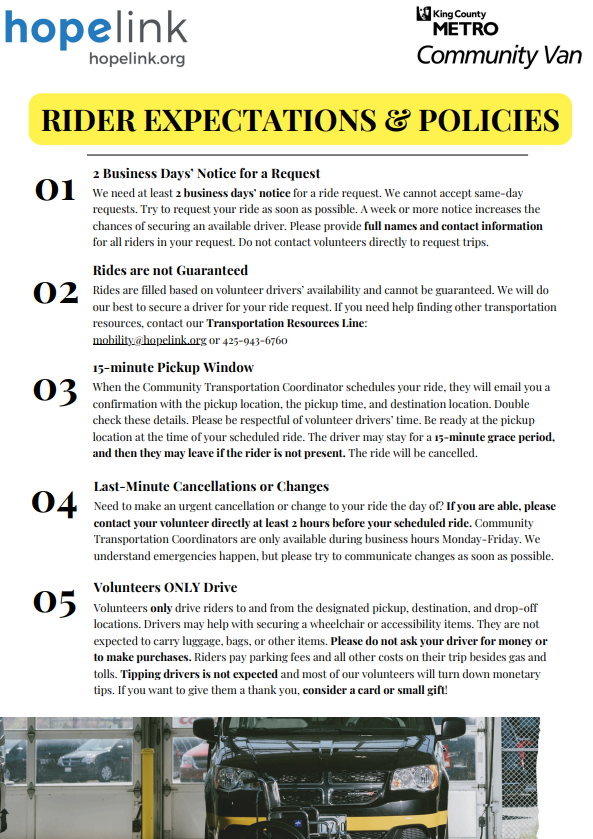
In addition to rider responsibilities,
Ride Connection’s Rider Service Guide includes reminders about keeping personal records up-to-date, its policy about traveling with animals, and a list of prohibited activities. This Guide is available in full in the
Appendix to Section 7: Case Studies.
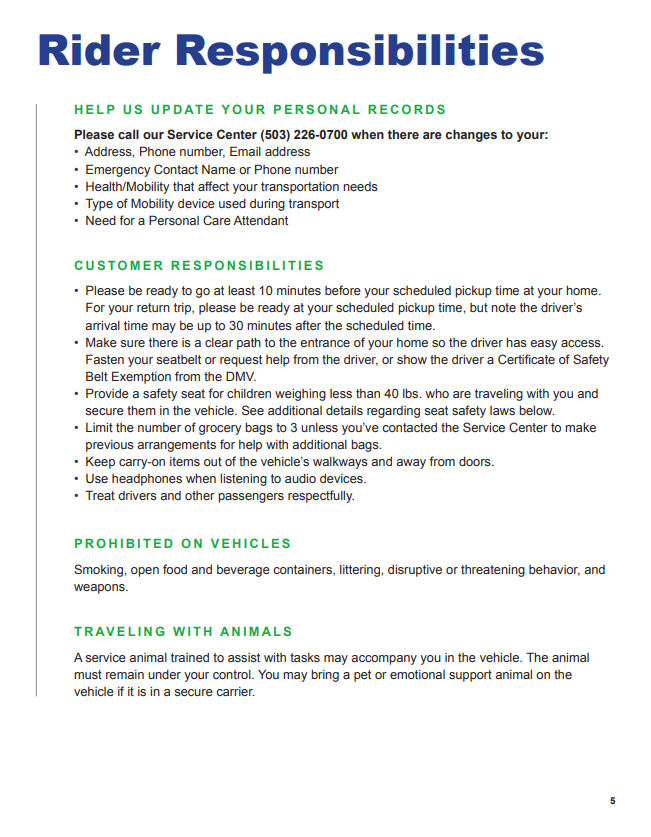
Children
Many volunteer driver programs and sponsoring organizations choose to require that an adult, other than the volunteer driver, accompany riders under the age of 11. Other transit systems allow children, ages six and over, to ride unaccompanied. To avoid confusion for riders and drivers, volunteer driver programs should have written policy and guidance on the transport of children.
For example:
King County Metro Community Van’s Rider Welcome Packet
includes Expectations for Youth Riders and a link to
Community Van’s Child Rider Consent Form. These materials are available in full in the
Appendix to Section 7: Case Studies.
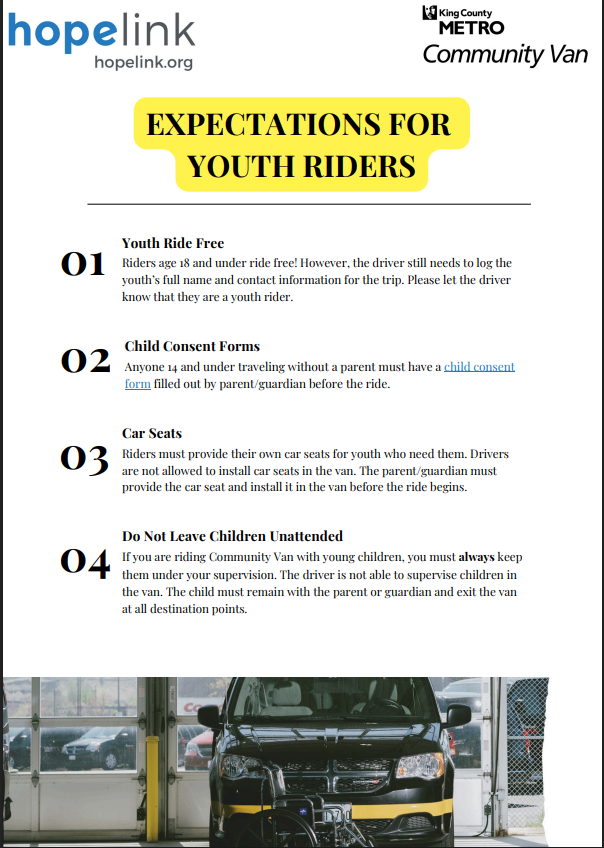
Ride Connection’s Rider Service Guide states the program’s policy - “Children under 8 years must be accompanied by a responsible party.” – and includes applicable child safety seating laws. The Guide is available in full in the
Appendix to Section 7: Case Studies.
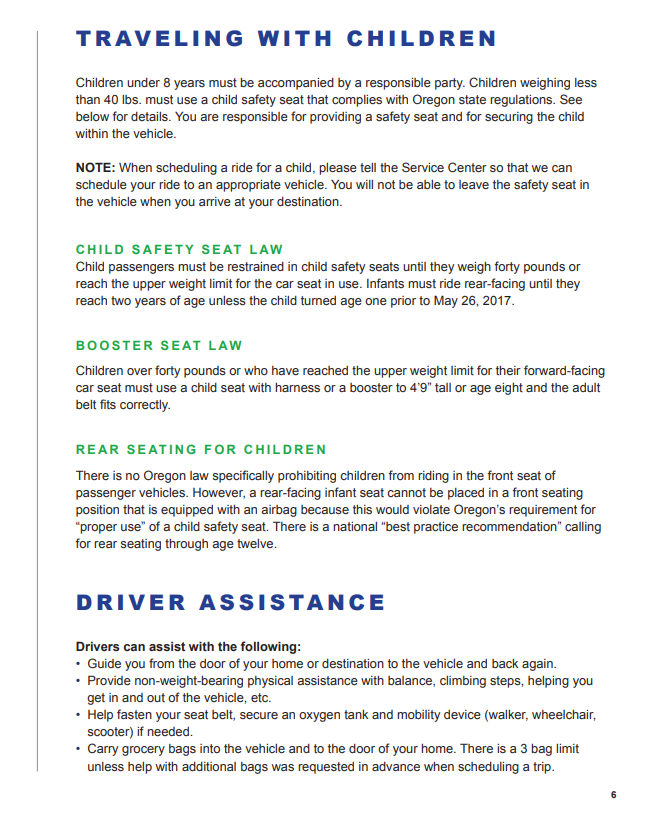
For additional information on training for drivers, see Car Seats and Child Securement in Section 4: Establishing and Managing a Volunteer Driver Pool.
Rider Surveys
Rider surveys should be conducted annually to assess service quality and identify areas for improvement. Surveying riders will help improve the services provided by the volunteer driver program. A Volunteer Transportation Rider Survey template is included in Section 8: Model Forms (Templates), Policies, and Procedures.
Survey Best Practices:
- Use multiple distribution methods (paper, online, phone interviews).
- Include both quantitative and qualitative questions.
- Analyze responses to improve service quality.
Example Question Topics:
- Overall satisfaction with ride experience.
- Ease of scheduling and availability of rides.
- Courteousness and professionalism of volunteer drivers.
Rider Grievances
Occasionally riders will have grievances about aspects of the program, including restrictions and denial of services or the quality of the service they received. Volunteer driver programs and sponsoring organizations should have both procedures and forms for handling these situations. Riders’ specific complaints can be recorded on an Incident Report. However, it is also very important that volunteer driver programs and sponsoring organizations document all complaints and what actions were taken as a result.
It is recommended that volunteer driver programs have a clear rider grievance or complaint process in place that includes the timeframe for a resolution, steps in the appeals process, and follow-up procedures for unresolved complaints.
- Complaint submission: Riders submit grievances through a written or verbal complaint form.
- Internal review: Program administrators review the complaint and assess necessary actions.
- Resolution and Follow-up: A formal response is provided within a set timeframe (e.g., 10 business days).
- Appeal process (if applicable): If unresolved, riders may appeal through a designated review panel.
In some cases, funding agencies will be responsible for investigating and following specific policies and procedures when responding to rider complaints. It is important that volunteer driver programs and sponsoring organizations be familiar with funding agency requirements regarding reporting of complaints. See
Funding in
Section 2: Volunteer Driver Programs of this Toolkit. A sample Transit Complaint Policy and Rider Grievance template are included in
Section 8: Model Forms (Templates), Policies, and Procedures.
Section Resources
- Green Mountain Transit (GMT)
- HopeLink’s Community Van Program
- King County Metro Community Van’s Rider Welcome Packet, Community Van’s Child Rider Consent Form
- National RTAP’s ADA Toolkit, Rider Assistance and Customer Service
- National RTAP Technology Tools Support Center, Website Accessibility
- Ride Connection’s Rider Service Guide
- Section508.gov website
- Texas Department of Public Safety, How to Apply for a Texas Identification Card website
- Washington Department of Licensing, Get an ID card website
- Web Accessibility Initiative (WAI), Web Content Accessibility Guidelines (WCAG), WCAG 2.1 at a Glance web page
- WebAIM Introduction to Web Accessibility website.
Updated October 2025

National RTAP offers one-stop shopping for rural and tribal transit technical assistance products and services. Call, email, or chat with us and if we can’t help with your request, we’ll connect you with someone who can!
" National RTAP offers one-stop shopping for rural and tribal transit technical assistance products and services. Call, email, or chat with us and if we can’t help with your request, we’ll connect you with someone who can! "
Robin Phillips, Executive Director
" You go above and beyond and I wanted to let you know that I appreciate it so much and always enjoy my time with you. The presentations give me so much to bring back to my agency and my subrecipients. "
Amy Rast, Public Transit Coordinator Vermont Agency of Transportation (VTrans)
" I always used the CASE (Copy And Steal Everything) method to develop training materials until I discovered RTAP. They give it to you for free. Use it! "
John Filippone, former National RTAP Review Board Chair
" National RTAP provides an essential service to rural and small transit agencies. The products are provided at no cost and help agencies maximize their resources and ensure that their employees are trained in all aspects of passenger service. "
Dan Harrigan, Former National RTAP Review Board Chair
" We were able to deploy online trip planning for Glasgow Transit in less than
90 days using GTFS Builder. Trip planning information displays in a riders'
native language, which supports gencies in travel training and meeting Title VI
mandates. "
Tyler Graham, Regional Transportation Planner Barren River Area Development District
Slide title
" Having a tool like GTFS Builder is really light years ahead of what it used to be at one time in terms of how fast you can put everything together. Our university students really can't imagine transit without it, so I think it's very important for us in terms of attracting that particular demographic. "
Michael Lachman, Transportation Services Manager HAPCAP - Athens Transit
Slide title
" In the past we used proprietary database software that was very challenging, very murky, and hard to update. GTFS Builder is a great opportunity to make this more user-friendly, more readily updatable and it
would enable us to show how to create a GTFS to more of the staff. "
Jaime McKay, Former Manager of Direct Services Center for Mobility Equity
Slide title
" Collaboration is a buzz word these days in the industry. On behalf of our Tribal segment, I appreciate RTAP for making Tribes a partner in industry opportunities. The organization goes over and beyond reaching partners one would not expect in a busy industry such as public transportation. Thank you for your tireless efforts! "
Franklin Akoneto, Comanche Nation
Slide title
"We are so very thankful for all your transportation training materials. Your resources are as valuable as gold!"
Holly Walton, Transportation Assistant Manager, Curative Connections
A program of the Federal Transit Administration administered by the Neponset Valley TMA
National RTAP is committed to making this website accessible to persons with disabilities. If you need assistance accessing any content on our website or need alternative formats for our materials, please contact us at info@nationalrtap.org or 781-404-5020.
by National RTAP |
